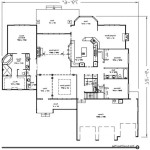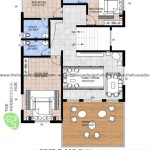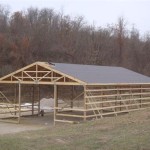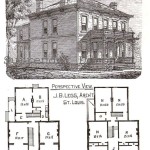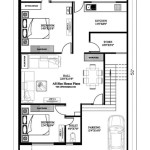Sample House Plans With Dimensions: A Guide to Understanding and Utilizing Architectural Blueprints
House plans with dimensions are essential tools for anyone involved in the process of building or renovating a home. These blueprints provide a detailed visual representation of the intended structure, including the size and layout of rooms, walls, doors, windows, and other key features. Understanding how to read and interpret these plans is crucial for architects, contractors, and homeowners alike, ensuring that the final product aligns with the initial design and specifications.
When examining house plans, the dimensions are critical because they dictate the actual size and proportion of the house and its individual parts. Accurate dimensions are non-negotiable for avoiding costly errors during construction. They also allow homeowners to visualize the space and plan for furniture placement and overall use of each room. The dimensions also serve as a common language between all parties involved, reducing ambiguity and facilitating effective communication.
The presence of dimensions on a plan ensures that all the building materials are accurately measured and cut to size. Miscalculations can lead to a chain reaction of errors, increasing material waste, labor costs, and project delays. Therefore, a meticulous approach to reading and applying the dimensions is paramount for a successful construction project. Furthermore, accurate dimensions on pre-approved plans are necessary for building permits and zoning compliance, ensuring that the proposed structure meets all regulatory requirements.
Understanding the Different Types of House Plans
House plans come in various forms, each serving a specific purpose and providing a different level of detail. Some common types of house plans include: foundation plans, floor plans, elevation plans, and site plans. Each type has its place and importance in the overall documentation.
Foundation plans depict the foundation of the house, including the location of footings, walls, and support columns. These plans specify the type of foundation material and the dimensions of each component. Knowing the location and dimensions of the foundation is vital for setting the stage and ensuring the structural integrity of the building.
Floor plans represent a top-down view of each level of the house, showing the arrangement of rooms, walls, doors, windows, and fixtures. Dimensions on floor plans indicate the overall size of each room, the width of hallways, and the placement of key elements like appliances and plumbing fixtures. Floor plans are generally the most common and useful documents for most people looking at house designs.
Elevation plans illustrate the exterior views of the house from different angles, showcasing the architectural style, the placement of windows and doors, and the roofline. Dimensions on elevation plans indicate the height of the walls, the size of windows and doors, and the roof pitch. These plans allow for the visualization of the finished exterior appearance.
Site plans show the location of the house on the property, including the driveway, sidewalks, landscaping, and utilities. Dimensions on site plans indicate the setbacks from property lines, the location of utility connections, and the overall lot size. These plans are important for municipal approval and for understanding the relationship between the house and the surrounding environment.
Beyond these basic types, other specialized plans may be included, such as electrical plans, plumbing plans, and HVAC (heating, ventilation, and air conditioning) plans. These plans provide details about the respective systems within the house, including the location of outlets, pipes, and ductwork. Even with specializations, dimensions are often provided to ensure accurate placement within the larger context of the house design.
Key Elements and Symbols in House Plans
House plans utilize a standardized set of symbols and notations to represent different building components and features. Understanding these symbols is crucial for interpreting the plans accurately. Walls are typically represented by thick lines, with different types of walls indicated by different line styles (e.g., solid lines for exterior walls, dashed lines for interior walls). Doors are shown as arcs, indicating the direction of swing, and windows are indicated by a series of parallel lines.
Dimensions are usually displayed as horizontal or vertical lines with arrows at each end, indicating the distance between two points. Dimensions are typically given in feet and inches, with the feet symbol (') and the inches symbol (") used to denote the units (e.g., 12'6" means 12 feet, 6 inches). It is vital to understand the specific dimensions and units being used in the plan.
In addition to lines and symbols, house plans often include notations highlighting specific materials, finishes, or construction details. These notations may refer to material specifications (e.g., "2x4 studs @ 16" o.c." indicating 2x4 studs spaced 16 inches on center) or to the type of finish (e.g., "hardwood flooring"). Notations are crucial for conveying precise information about the intended construction methods and materials.
Another common feature of house plans is the use of abbreviations. Many standard architectural terms are shortened for conciseness. Some common abbreviations include: CL (centerline), TYP (typical), REF (refrigerator), DW (dishwasher), and WH (water heater). Familiarity with these abbreviations can substantially speed up the plan reading process.
It is also critical to understand the concept of "scale" in relation to house plans. The scale represents the ratio between the size of the drawing and the actual size of the building. A common scale for house plans is 1/4" = 1', meaning that one-quarter of an inch on the drawing represents one foot in reality. Checking the scale before interpreting any dimensions is essential to ensure accurate understanding.
Practical Applications of Dimensions in Building and Remodeling
Dimensions play a fundamental role in various aspects of building and remodeling. During the initial design phase, dimensions are used to define the size and layout of rooms, ensuring that they meet the intended functionality and aesthetic requirements. The proper allocation of square footage to different areas of the house is crucial for creating a comfortable and efficient living space. Dimensions also impact the placement of doors and windows, which can in turn affect the natural light and ventilation within the home.
During the construction phase, dimensions are used to accurately lay out the walls, floors, and roof of the house. Contractors rely on dimensions to cut and assemble building materials, ensuring that the structure is built according to the specifications. Precise dimensions are also essential for the installation of plumbing, electrical, and HVAC systems, ensuring that these systems function properly and safely. A building with incorrect dimensions can create numerous safety hazards.
When remodeling or renovating a home, dimensions are used to plan changes to the existing structure, such as adding a new room, reconfiguring the layout, or updating finishes. Dimensions are crucial for determining the feasibility of these changes, ensuring that they comply with building codes and do not compromise the structural integrity of the house. In remodeling projects, careful examination of existing dimensions and their relationship to the revised plan is crucial for avoiding costly mistakes.
Furthermore, homeowners can use dimensions to plan for furniture placement and interior design. By knowing the size of each room, homeowners can select furniture that fits comfortably and aesthetically pleasing. Dimensions also help homeowners to visualize the flow of traffic within the house, ensuring that pathways are clear and that the space is utilized efficiently. Homeowners can use online tools and dimension guidelines to ensure their furniture and appliances will fit as planned.
Finally, understanding house plans with dimensions is critical for obtaining building permits and ensuring compliance with local zoning regulations. Building departments require detailed plans with accurate dimensions to verify that the proposed construction meets all applicable codes and requirements. Failure to comply with these regulations can result in delays, fines, or even the rejection of the building permit. Therefore, a clear understanding of dimensions is not only essential for the construction process but also for navigating the regulatory landscape.

12 Examples Of Floor Plans With Dimensions

12 Examples Of Floor Plans With Dimensions

House Plans How To Design Your Home Plan

12 Examples Of Floor Plans With Dimensions

How To Read A Floor Plan With Dimensions Houseplans Blog Com

Sample Floor Plan Image With The Specification Of Diffe Room Sizes Scientific Diagram

Floor Plans Template Beautiful Ready To Use Sample Plan Drawings Templates Easy Simple Design Drawing

Floor Plans With Dimensions Including Examples Cedreo

A Floorplan Of Single Family House All Dimensions In Meters Scientific Diagram

Sample Floorplan Floor Plan Template

